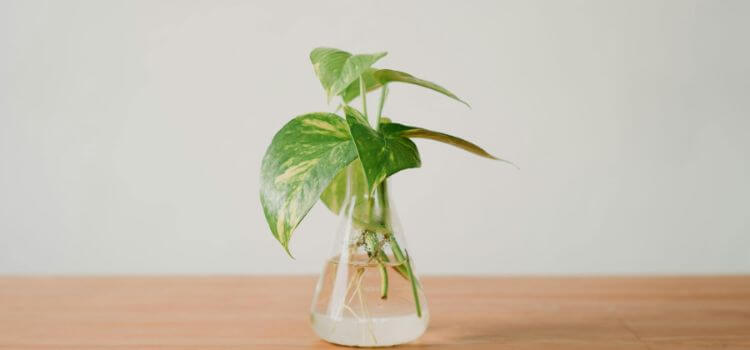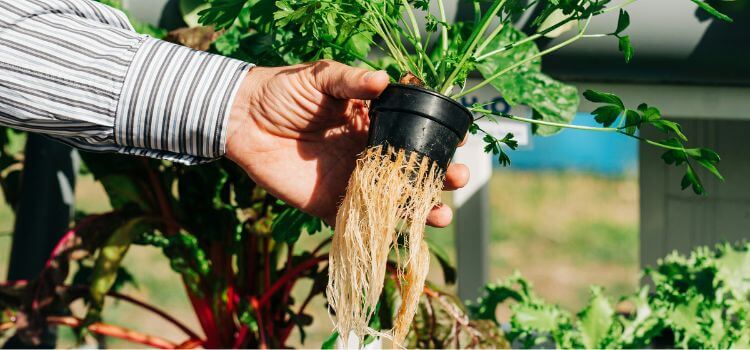As an Amazon Associate, I earn from qualifying purchases.
Prevent root rot in hydroponics by maintaining clean water and providing adequate oxygen to the root zone. Regularly check pH and EC levels to ensure a balanced nutrient solution.
Hydroponic root rot can destroy plants, but you can grow a healthy garden with careful prevention. Starting with a system that promotes good aeration and water circulation is essential. Stable environmental conditions limit root disease risk; therefore, monitor them frequently.
Keeping the nutrient solution at an optimal temperature and ensuring your plants are well-rested are pivotal steps. Regular cleaning of your hydroponic setup minimizes the threat of pathogens that can cause root rot. Promoting these principles boosts plant growth and hydroponic system productivity.
Root Rot In Hydroponic Systems
Hydroponic systems offer a unique way to grow plants without soil. Yet, they can encounter a thorny issue – root rot. Spotting this early ensures healthy plant growth.
Signs Of Root Health Issues
Visible signs of distress in your hydroponic garden often start below the surface. Observe your plant’s roots regularly for these symptoms:
- Brown or black roots: Healthy roots appear white or cream.
- Slime on roots: Indicates decay.
- Lousy odour: Healthy roots should not smell foul.
- Stunted growth: Check for slowed development.
Leaves can also show signs like wilting or yellowing. Regular checks play a crucial role in preventing root rot.
Common Causes Of Root Rot
Understanding why root rot occurs helps in its prevention. The typical culprits include:
| Cause | Description |
|---|---|
| Poor Circulation | Water must move to prevent stagnation. |
| Excess Heat | High temperatures encourage bacteria growth. |
| Overfeeding | Too many nutrients lead to build-up. |
| Pathogens | Bacteria and fungi thrive in wet environments. |
Cleanliness is vital. Regularly sanitize your system to keep your roots happy and healthy.

The Science Behind Root Rot
Hydroponic systems give plants a unique growing environment. However, they can also invite root rot, a common but serious issue. Understanding how to root rot develops is vital to preventing it. Here, we dive into the science behind root rot, focusing on oxygen’s role in root health and the dynamics of plant pathogens.
Role Of Oxygen In Root Health
Roots need oxygen to stay healthy and function properly. In a hydroponic setup, oxygen levels in the water can determine a plant’s fate. Without enough oxygen, plants cannot absorb nutrients effectively, leading to weak roots and potential rot. Good oxygenation in hydroponic systems encourages strong root growth and keeps rot at bay.
- Use air stones or pumps to increase water circulation.
- Avoid overcrowding your setup to ensure each plant gets enough air.
- Monitor water temperature, as cooler water holds more oxygen.
Pathogens And Disease Dynamics
Pathogens like fungi and bacteria can cause root rot in plants. Hydroponics’ warm, stagnant conditions favour these undesirable intruders. Understand these infections’ activities and plant root interactions to control them.
| Pathogen Type | Conditions They Favor | Prevention Strategy |
|---|---|---|
| Fungi | Warm, oxygen-poor water | Ensure system cleanliness and oxygenation |
| Bacteria | Organic material buildup | Remove dead plant matter promptly |
- Regularly monitor and adjust pH levels.
- Use quality water sources to avoid contamination.
- Include beneficial microbes to outcompete harmful organisms.
Proactive Measures For Healthy Roots
Root rot can devastate hydroponic plants. Healthy roots make for thriving plants.
Preventing root rot needs early action. Gear up our systems and keep the water pristine to protect our green friends.
Choosing The Right System Design
The first step is selecting an appropriate hydroponic system. Different designs cater to various plant needs and spaces.
- Recirculating systems save water but need close monitoring.
- Non-recirculating systems are simpler but use more water.
Ensure your system allows enough oxygen to reach the roots. Oxygen-rich environments deter root rot.
| System Type | Oxygenation | Monitoring Needs |
|---|---|---|
| Deep Water Culture (DWC) | High | Medium |
| Ebb & Flow | Medium | High |
| Nutrient Film Technique (NFT) | High | High |
| Drip System | Low to Medium | Medium |
Regular Water Quality Assessments
Keeping water fresh and clean is vital in warding off root rot. Test the water every week for pH levels and nutrient strength.
- Maintain pH between 5.5 to 6.5.
- Adjust nutrients based on plant growth stages.
Change the water every two to three weeks to prevent pathogens. Use EC meters and pH test kits for accuracy.
Effective Water Management Strategies
Keeping plants healthy in hydroponic systems demands competent water handling. Effective water management strategies are vital in preventing root rot, a common issue that can devastate hydroponically grown plants. These strategies ensure plants get the right balance of nutrients and oxygen, preventing harmful pathogens from thriving.
Temperature And Nutrient Balance
Roots prosper with optimal water temperature and adequate nutrients. Cool temperatures slow growth, but too warm temperatures can invite diseases. Aim for 18-22°C (65-72°F) for most plants. Use a thermometer to track water temperature regularly.
A consistent nutrient balance is vital. Test nutrient levels with a digital meter. Adjust the mix according to plant stages:
- Seedlings need lighter nutrient concentrations
- Maturing plants require more nutrients
Change the solution every two weeks to maintain balance.
Circulation Techniques To Prevent Stagnation
Good circulation prevents water from becoming stagnant. Stagnant water can harm plant roots. Use air stones and water pumps for continuous water movement. This helps:
- Increase oxygen in the water
- Prevent the growth of harmful pathogens
- Enable nutrients to reach plant roots evenly
Clean your system’s filters and pipes often. This keeps circulation smooth and roots healthy.

Advanced Solutions For Root Rot Prevention
Keeping plants healthy in hydroponic systems demands competent water handling. Effective water management strategies are vital in preventing root rot, a common issue that can devastate hydroponically grown plants. These strategies ensure plants get the right balance of nutrients and oxygen, preventing harmful pathogens from thriving.
Temperature And Nutrient Balance
Roots prosper with optimal water temperature and adequate nutrients. Cool temperatures slow growth, but too warm temperatures can invite diseases. Aim for 18-22°C (65-72°F) for most plants. Use a thermometer to track water temperature regularly.
A consistent nutrient balance is vital. Test nutrient levels with a digital meter. Adjust the mix according to plant stages:
- Seedlings need lighter nutrient concentrations
- Maturing plants require more nutrients
Change the solution every two weeks to maintain balance.
Circulation Techniques To Prevent Stagnation
Good circulation prevents water from becoming stagnant. Stagnant water can harm plant roots. Use air stones and water pumps for continuous water movement. This helps:
- Increase oxygen in the water
- Prevent the growth of harmful pathogens
- Enable nutrients to reach plant roots evenly
Clean your system’s filters and pipes often. This keeps circulation smooth and roots healthy.
| Additive | Dosage |
|---|---|
| Hydrogen Peroxide | 3% solution, 2 ml per litre |
| Silica | 1 ml per liter |
| Enzymatic Formula | 5 ml per gallon |
Harnessing Beneficial Microorganisms
Beneficial bacteria and fungi form a protective net around hydroponic roots. They fight off rot-causing organisms. A few champions here:
- Bacillus subtilis: A bacterial knight shielding roots from disease.
- Trichoderma: A fungal ally, devouring harmful pathogens.
Integrate these microorganisms easily with ready-to-use inoculants. Be sure to follow the product’s guidelines for maximum effect.
Monitoring And Responding To Root Health
Vigilant care for roots in hydroponics distinguishes between a thriving garden and a failing crop. Healthy roots mean healthy plants. A proactive approach is essential. Monitoring roots ensures any sign of trouble prompts immediate action. They are keeping roots at their best, from detection to recovery.
Early Detection Protocols
Early detection of root problems can save your plants. Each day, take time to observe root colour and texture. Healthy roots appear white and firm. Note changes, as they could signal issues.
- Check for sliminess on roots, a common rot sign.
- Measure water temperature; roots need cool to moderate temps.
- Monitor the pH levels closely; roots favour slightly acidic conditions.
- Use a PPM meter to keep nutrient levels in check.
Log these observations in a daily journal to track your hydroponic system’s health. Graphs or tables can help spot trends over time.
Intervention And Recovery Plans
When early signs suggest root health is at risk, clean and change the water immediately. Adjust nutrient levels and pH balance as needed.
For ongoing treatment, consider beneficial bacteria additives that fight rot-causing pathogens. Hydrogen peroxide can add oxygen to water, helping roots breathe.
| Issue | Action | Recovery Time |
|---|---|---|
| Discolored Roots | Clean system; Adjust lights | 1-2 weeks |
| Root Slime | Change solution; Use sterilizing agents | Varies |
| Stunted Growth | Correct nutrients; Ensure proper airflow | 2-4 weeks |
Roots can recover with proper intervention. Regularly check on them post-treatment to confirm a return to health. If problems persist, reassess your plant’s environment and adjust as necessary.

Frequently Asked Questions Of How To Prevent Root Rot In Hydroponics
-Hydroponic systems prevent root rot by ensuring proper aeration and nutrient circulation. They maintain optimal water conditions and avoid overwatering, keeping roots healthy and functioning efficiently. Regular system checks and cleanings also help prevent pathogen buildup.
Prevent root rot in water-grown plants by changing the water weekly. Filtered water, adequate lighting, air stones, and regular sterilization are needed.
Root rot in hydroponic lettuce often results from waterlogged conditions, which foster fungal pathogens like Pythium. Poor oxygenation and unbalanced nutrient solutions also contribute to this issue. Regular system maintenance can help prevent its occurrence.
Hydrogen peroxide and copper-based fungicides are commonly used to treat root rot in hydroponic systems. They effectively control the spread of the disease.
Conclusion
Ensuring the health of your hydroponic plants means staying vigilant against root rot. Our advice for adequate cleanliness, balanced nutrient distribution, and diligent monitoring can help you grow a healthy garden without root damage.
Remember, prevention is vital to maintaining a potent hydroponic system. Be proactive in root rot protection to keep your green thumb educated and plants growing.

